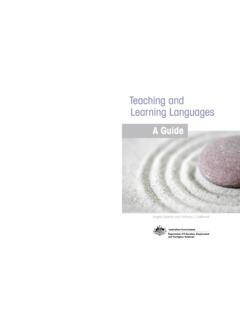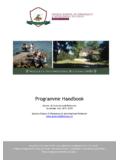Transcription of Language awareness and its relevance to TESOL
1 University of Sydney Papers in TESOL 1 Language awareness and its relevance to TESOL ELIZABETH M. ELLIS University of New England ABSTRACT Language awareness (LA) is widely considered to be an important dimension of ESOL teachers professional knowledge. This paper considers how Language awareness has been defined and examines which aspects are foregrounded in various conceptions of Language awareness . Samples of professional competency statements and tasks commonly given to pre-service teachers are provided to illuminate the aspects of Language awareness that are given prominence in ESOL. The paper examines the aspects of Language awareness that are fostered by current practices in teacher education and professional development and discusses which aspects of Language awareness are desirable for teachers to develop.
2 Excerpts from studies of pre-service and in-service teachers are used to suggest that teacher LA is strengthened by L2 learning experience, and to argue for the value of Language learning awareness . It is argued that LA has been through a pendulum swing from a cross-lingual focus to a focus on English-only, and is now in the process of returning to a renewed and reinvigorated multi-lingual focus. DEFINING Language awareness Language awareness (LA) is a term commonly heard in TESOL teacher education; often as part of a discussion about whether teachers-in-training have sufficient LA to do well in their practicum Address for correspondence: Elizabeth Ellis, Linguistics, School of Behavioural, Cognitive and Social Sciences, University of New England, Armidale, NSW 2351, Australia; Email: University of Sydney Papers in TESOL , 7, 1-23.
3 2012 ISSN: 1834-3198 (Print) & 1834-4712 (Online) Elizabeth M. Ellis 2 and, ultimately, in the classroom. What exactly is Language awareness and what relevance does it have for teachers and learners of ESOL? Like many such terms it has multiple meanings, and the intention of this paper is to explore some of those meanings and attempt to isolate the meanings most useful for the TESOL field. This paper does not attempt to give a comprehensive overview of the field of LA. To do so would require incursions into cognitive aspects of second Language acquisition, such as attention and noticing, and a more in-depth treatment of teacher cognition. For these aspects the reader is referred to Svalberg s thorough treatment of multiple aspects of LA (2007) and Borg s book-length overview of Language teacher cognition (2009).
4 In this paper, I wish to locate the origins of LA within a multilingual contrastive tradition, trace its change into a monolingual model, and argue that the time is ripe for a renewal of its multilingual roots, albeit with new insights resulting from recent research into the dynamic nature of multilingualism. A current definition of LA is that of the Association for Language awareness (ALA), which states that LA can be defined as explicit knowledge about Language , and conscious perception and sensitivity in Language learning, Language teaching and Language use (ALA, 2012). Their definition continues: [i]t covers a wide spectrum of fields. For example, Language awareness issues include exploring the benefits that can be derived from developing a good knowledge about Language , a conscious understanding of how languages work, of how people learn them and use.
5 Language awareness , according to ALA, is relevant for the learner, the teacher, the teacher-learner, the bilingual and the layperson. The paper touches on each of these (except the layperson which is outside the scope of this paper), but takes its main focus as the TESOL teacher-learner. Many of the early views on LA in the English-speaking world came from Language education in the , including first Language education, Language across the curriculum, and second Language learning. The focus was firmly on the learner with English as L1. One of the most influential and frequently-cited definitions of LA is that given by Donmall (1985) in her report prepared for the UK National Congress on Languages in Education (NCLE) ( ): Language awareness is a person s sensitivity to and conscious awareness of Language and its role in human life.
6 University of Sydney Papers in TESOL 3 The NCLE arose out of concerns expressed in the Bullock Report (DES, 1975), which had been set up to address growing anxiety about standards of literacy in schools in England. In fact the Bullock Report went beyond its brief and considered the broader question of the role of Language in education (Hawkins, 1999, ). The NCLE sought to co-ordinate the interests and needs of all Language areas with the Language awareness framework (Donmall, 1984, ). These Language areas included mother tongue teaching of English and other languages, foreign languages, EFL, ESL and linguistics. Key drivers behind national reports and working parties were several: the view that the UK s record of teaching foreign languages was dismal and compared poorly with equivalents in the European Union (then the EEC) countries; increasing immigration and the concomitant desire of communities for support in maintaining their children s first Language ; the realisation that with the demise of formal grammar teaching, children s knowledge of English as a mother tongue was poor; and the need for ESL in an increasingly multicultural society (Donmall, 1984).
7 Eric Hawkins, sometimes called the father of Language awareness , had been advocating since the 1960s for explicit reflection on both native and foreign languages as an integral part of the school curriculum. He proposed a trivium of Language studies, which consisted of mother tongue study, foreign Language studyi and Language awareness work (Hawkins, 1984, ). In this model, learners would be assisted to develop skills such as noticing and the articulating of linguistic intuitions, and to apply them both to their mother tongue and to the Language (s) they learn. There was a strong emphasis on broadening of students thought and of guarding against ethnocentrism in Britain s increasingly diverse society.
8 Hawkins (1984) saw LA work as ( ): ..light[ing] fires of curiosity about the central human characteristic of Language which will blaze throughout our pupils lives. While combating linguistic complacency, we are seeking to arm our pupils against fear of the unknown, which breeds prejudice and antagonism. LA, then, was thought to be beneficial firstly in terms of a lifelong ability to understand how Language affects human life, and secondly in terms of increasing the likelihood of cross-cultural understanding a desire echoed in Australia s own first National Languages Policy (Lo Elizabeth M. Ellis 4 Bianco, 1987) and followed by research on the contribution of Language learning for intercultural communication (Lo Bianco, Liddicoat & Crozet, 1999).
9 There were three main ways in which Hawkins (1999) saw foreign Language learning contributing to Language awareness ( ): providing positive feedback on the mother tongue and cultural stereotypes; encouraging the learner to pay close attention to words and their meanings; building confidence in what Halliday (1975) called the mathetic function of Language ( , using Language to learn about the world). Carl James (1999), another British researcher working with the same model as Hawkins, claimed that ( ): .. one s understanding of the workings of the foreign Language can be illuminated by mother tongue study, by transferring one s mother tongue metacognitions to the task of foreign Language learning. Seeing mother tongue and foreign Language objectively , first in terms of their immanent systematicity, and then each in terms of the other, is to develop one s linguistic metacognitions of each.
10 We see then the preoccupation of these early contributors to the LA movement in the English-speaking world with the links between L1 and L2 learning. This is hardly surprising since James was a major force in Contrastive Analysis, which actively encouraged the contrasting of L1 and L2. While Contrastive Analysis itself has given way to more nuanced views of learner Language , there has been in recent years more interest in the role of L1 in the second and foreign Language classroom (Oguro, 2011; Turnbull & Arnett, 2002). EFL TEACHERS Language awareness Here I examine the view of Language awareness within a particular tradition of Language teacher training: that which had its origins in London in 1962 in the organisation International House (IH).





